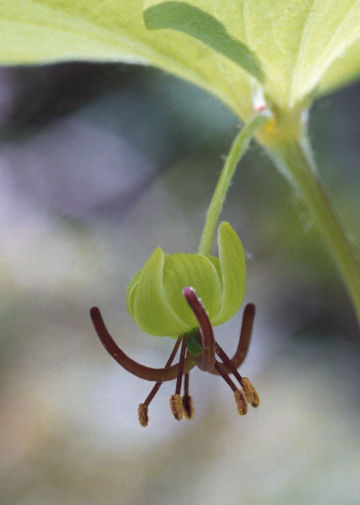Village News

PHOTO COURTESY OF GARRY KESSLER
Blossom of Indian cucumber root.
June 18, 2021, Page 2A
NATURE NOTES
By Annie Reid
Westborough Community Land Trust
Indian cucumber root – a shy wildflower
June is a month of lush growth as spring fades into summer.
Field wildflowers such as daisies bloom on sunny roadsides, weeds threaten to overrun our gardens, and leaves darken the woods. Yet there are hidden wildflower treasures to be discovered along wooded trails. If ever there was a perfect example of a shy woodland wildflower, Indian cucumber root is it.
Indian cucumber root (Medeola virginiana) blooms with spidery, nodding flowers and eventually bears blue-purple berries, but the leaves, not the blossoms, are usually the secret to spotting the plant. June's foliage may seem overwhelming in the woods, but if you glance at the side of the trail you're walking, the whorls of lance-shaped leaves of Indian cucumber root may catch your eye. (What's a whorl? It's a circle of leaves all growing out from one point on a stem.)
Indian cucumber root plants grow one to two feet high, with just a single stem – no branches – bearing one or two whorls of pointed, lance-shaped leaves. Plants that are going to bloom develop two whorls of leaves. The lower whorl typically has seven leaves, but can have five to nine. The top whorl usually has three or four leaves. The plants are perennial, and those that aren't going to bloom this year have only one whorl.
In June, look for the dangling blossoms, which develop from the upper whorl. The flowers are showy in their own way, although they're small, about half an inch. They may be yellow or greenish, with petals that curve back. Indian cucumber root is a native member of the lily family and blooms around the time when wild and garden lilies bloom.
Later in the summer, from July onward, the leaves are once again a good clue to what's happening. Indian cucumber root's shy show continues as berries ripen from green to blue-purple. The leaves of the top whorl turn red at their base, advertising the presence of berries. Birds are attracted to the berries, but this fruit is not edible for humans.
As the name suggests, Native Americans had good reasons for seeking out this plant. They dug the root for food. It's reportedly crisp with a flavor like cucumber. The plants today are not abundant enough for us to be digging them up – so please don't. Native Americans also had medicinal uses for tea made from the leaves or berries, which had diuretic effects.
Indian cucumber root does well in moist, shady woods. Throughout the growing season, it puts most of its energy underground, storing carbohydrates in the root. This reserve enables the plant to survive various mishaps in the forest, overwinter, and bloom and reproduce in the spring.
With its interesting leaves, blossoms, berries, root, and history of medicinal use, Indian cucumber root can be an intriguing addition to a native plant garden. Please get plants from a reputable nursery, not from the wild.